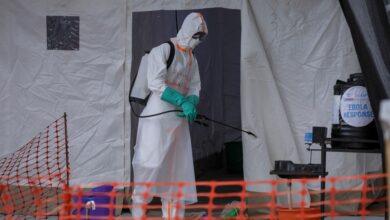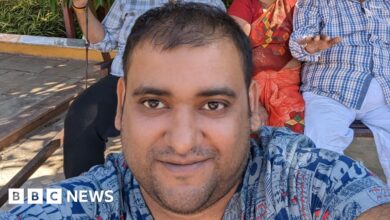‘Skull without a jaw’: Gaza survivors search for what remains of the dead | Israel-Palestine conflict News

Khan Yunis, Gaza Strip, Palestine – With a heavy heart, keen eyes and trembling hands, Abu Muhammad Ghaith was meticulously searching through the thick nylon bags used as makeshift shrouds for Who were killed in Gaza. Inside the morgue at Nasser Hospital in the southern city of Khan Yunis, he hoped to find a trace of his missing son. Instead, he was found with nothing but unidentified body parts and scattered remains.
The sight left him collapsed on the ground, overwhelmed with sadness and exhaustion. Still, he pulled himself together and continued searching for any trace of the 17-year-old Mohammed, shifting his focus from the bodies to the personal items: a pair of sandals patched with yellow plastic or an orange jacket, a black jacket, sweatpants — anything. Which could belong to his son.
“Has anyone seen a patched sandal with a yellow sole? Please, if you find it tell me,” Abu Muhammad appealed to others who like him came to the morgue early Tuesday to search for loved ones among the bodies. The remains of dozens of bodies The Palestinian Civil Defense recovered from under the rubble in Rafah, south of Khan Yunis, on the Egyptian border. Tears streamed down his face as he knelt down and leaned against the wall. “I’m no longer looking for his body, just his sandals. Do you see what we’ve come to?” He muttered, a mix of sadness and helplessness in his voice.
A The ceasefire came into force on Sunday The conflict between Israel and Hamas has enabled hundreds of thousands of Palestinians to return to their demolished homes in Rafah and other places in the Strip. The 15-month-old bombing has displaced nearly two million Palestinians in Gaza, many of whom have never had the opportunity to recover the bodies of their loved ones who died under the bombing and rubble.
The destroyed infrastructure and Israel’s targeting of ambulances and civil defense vehicles also hindered their ability to reach bomb-hit sites.
Mohammed has been missing since November. He had left the family’s displacement camp in Al-Mawasi to make what he said would be a quick trip to retrieve their belongings from their home in Rafah.
He never came back.
Abu Muhammad is sure that his son was killed by Israeli fire or bombing while trying to return to his home. “He wanted to recover some of our belongings and return to the camp. But he did not bring anything, and he did not return either,” he told Al Jazeera.

“Some bones.”
In the days that followed the Israeli army’s partial withdrawal from Rafah, local rescue teams and medical staff recovered dozens of remains and body parts, which were transferred to Al-Nasser Hospitals and the European Hospital in Khan Yunis for identification. As news spread, families of missing loved ones flocked to these sites, hoping to find closure.
For Abu Muhammad, this was his last hope of finding his son.
Since the day he disappeared, Abu Muhammad has spared no effort in searching for him. Contact the Red Cross, the Ministry of Health, and anyone who can help. He even returned to his destroyed home in Rafah and combed through its ruins. “I’ve searched everywhere. His mother is about to lose her mind, and his sisters are desperate for answers.”
The war led to the deaths of about 47,000 people, according to the Ministry of Health in Gaza. However, the world-renowned medical journal The Lancet expects the actual number of deaths to be lower 41 percent higher From the announced tally.
In May, the United Nations Office for the Coordination of Humanitarian Affairs (OCHA), the humanitarian arm of the United Nations, said that more than 10,000 people were believed to be buried under rubble in Gaza, adding that it could take up to three years to recover those bodies, given For very primitive tools in the sector. .
After hours of searching through the rubble of his destroyed house in Rafah, the sad Faraj Abu Mohsen found no trace of his son. On his way back to Khan Yunis, where his family was displaced, the 42-year-old found body parts and torn clothes about 200 meters (656 feet) from the rubble of his home – items he knew belonged to his son.
“I had lost hope of finding him alive. While returning to Khan Yunis after searching all day, I hit some bones in my feet. I moved them aside and revealed my son’s clothes: his black shirt, blue pants, and sneakers. “I knew it was him,” Faraj recalls sadly. He collected the remains in a bag, buried what he could, and promised to return to search for more.
“None of us imagined that all that would be left of him were a few bones,” he said, his voice heavy with sadness.

Identification challenges
Inside and outside the Nasser Hospital morgue, a painful scene occurred. Desperate families described their physical features or clothing in hopes of identifying their loved ones.
“My son recently had a dental implant,” one mother said.
“He was wearing blue jeans,” another father shouted.
Others talked about height, structure, or unique items like a cowboy hat or patchwork sandals.
Adding to the pain were the stark marks written on the shrouds: “Skull without lower jaw,” “Bone fragments,” “Rib cage,” or “Upper and lower limbs.” Instead of names and ages, medical teams documented the remaining details of Palestinians killed by Israeli artillery to help families identify their remains. Along with these notes, there were descriptions of personal items found with the remains, such as rings, watches, shoes, or damaged ID cards.
Dr. Ahmed Dhaher, a forensic medicine consultant at the Gaza Ministry of Health, explained that the lack of DNA testing capabilities in Gaza greatly hampers identification efforts, adding that Israel has imposed long restrictions on the entry of DNA testing equipment into the Strip. He added: “Without this technology, many bodies remain unidentified, leaving families in constant suffering.”
Dr. Zahir explained the identification process: Rescue teams first exhume the remains, then they are examined and documented. Details such as recovery location, date, and any personal items are recorded. Given the condition in which these bodies were found, forensic experts rely heavily on circumstantial evidence, such as clothing or possessions, to guide families.
“We follow legal protocol by keeping the bodies for up to 48 hours to allow families the opportunity to identify them,” Dr. Dharir said. “Then, the remains are buried by the Ministry of Endowments and Civil Defense in a designated cemetery, with specific numbers and records kept to determine their possible future identity.” If testing equipment is available.”
He also noted that a third of the remains recovered from Rafah so far – about 150 cases – remain unidentified.
“The most difficult cases are those involving partial remains: a skull, leg bones, or parts of a rib cage. They are carefully numbered and cataloged, but without DNA testing, final identification is often impossible,” he added.
Families in limbo
Dr. Zaher explained that current forensic resources in Gaza are limited, with only three specialists in the southern region and none in the north, adding that this shortage has strained an already overburdened system, especially with the sheer volume of bodies recovered in the wake of the attacks. Israeli.
For families like Abu Muhammad’s, the inability to locate or recognize their loved ones prolongs their grief. “We just want to know his fate,” Abu Muhammad said. “Even if all that’s left of my son is a bone, we want to bury him and say goodbye to him.”
Forensic teams face increasing pressure, not only from families, but also from the growing accumulation of remains. Dr. Daher stressed the need for international assistance. “We urgently need DNA testing equipment and trained professionals to help identify victims. This is not just about closure for families, it is a humanitarian necessity.
As efforts continue, families cling to hope, no matter how weak. For Abu Muhammad, the search for his son has become a daily ritual that he cannot abandon despite the emotional toll. “I’ve lost count of the number of shrouds I’ve opened. I don’t know if I’ll ever find him, but I’ll keep looking.”
The tragedy of the unidentified remains highlights the broader humanitarian cost of the conflict. Behind the staggering death toll lies an equally painful truth: families left in limbo, searching for answers in the ruins of their lives.
For many, lockdown seems like a distant dream – a dream stolen by war and a lack of resources to heal its wounds.
This piece was published in collaboration with For example.
https://www.aljazeera.com/wp-content/uploads/2025/01/Abu-Mohamed-Gaith-went-through-all-the-shrouds-looking-for-a-hint-of-his-son-including-a-patched-sandal.-Image-by-Mohamed-Solaimane-1737493959.jpg?resize=1920%2C1440
2025-01-22 07:23:00




